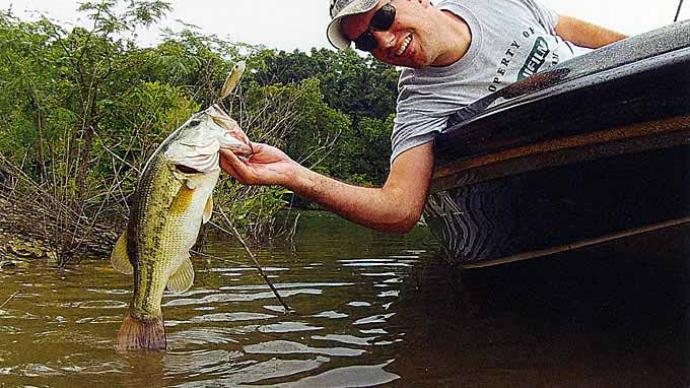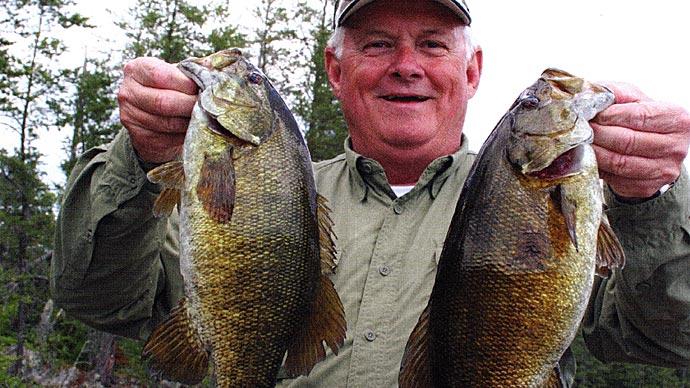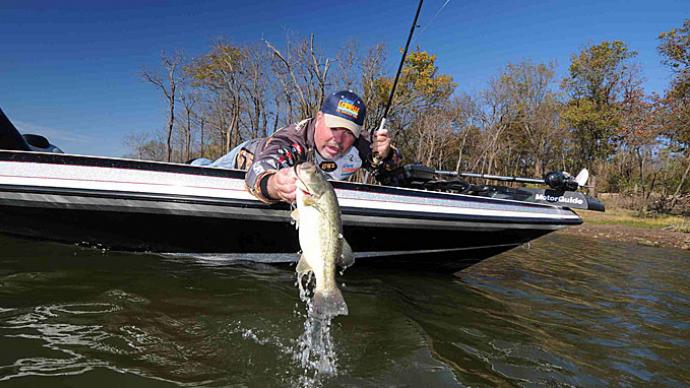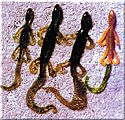
Few baits in the angler's arsenal have as many variants as the good old plastic worm. From its meager beginnings as a lure originally cut from old tire inner tubes, the plastic worm has become the mainstay for most anglers.
The basic plastic worm has mutated into more variants than a monster virus in a bad Sci-fi movie. Advances in mold manufacturing techniques, robotics, plastic and silicone materials, and lure designers' imaginations have allowed a quantum leap in soft plastic lure production. This, combined with the relative ease of the plastic material to work with, has created thousands of variations on the original plastic worm.
A glance through a retail fishing website or a trip to your local tackle shop will present you with a bevy of soft plastic baits you may never have seen before. Shapes, styles, and colors in soft plastic baits change more often than a politician's campaign platform during an election year.
Some anglers find themselves intimidated by plastics they may not have seen before. Anything other than the standard 6-inch purple curly tail may be foreign territory. Nevertheless, these anglers need not be afraid. Regardless of the style, all plastics are fished with techniques most anglers are already familiar with. Anglers need to become comfortable fishing a bait that looks more like something out of their kid's toy box than the local tackle store.
There are several basic ways to rig plastic baits. The most common include the Texas rig, Carolina rig, Splitshot rig, Dropshot rig, or dart head/jig head rig. These five rigging methods will accommodate almost all your fishing needs.
But what about these new plastic baits? How do we rig them, and what do we do with them? With this in mind, let's look at some of the more interesting plastic baits to hit the market in recent years.
Creature Baits
I'm not sure who came up with the term creature baits, but it is a nickname for any plastic bait that does not fall neatly into the worm, lizard, or crawdad category. These baits came into being as garage-manufactured contraptions that avid anglers made to give themselves an edge.
Mimicking Dr. Frankenstein, anglers got out their worm welders and started gluing together parts of worms and grubs until they came up with a bait that fit their needs.
Then a creature-type bait made by Gambler worms hit the national spotlight when Davy Hite won the 29th annual Bassmasters Classic fishing a "Bacon Rind." This bait, which looks like some worm/crawdad/lizard combination, was flipped below floating weeds to catch fish hanging underneath. This method and bait accounted for the $100,000 win.
The beauty of the creature-style bait is that you can do much with it. It can be used as a flipping or pitching bait, fished as a trailer on jigs, fished with a jig head, or fished with a Texas or Carolina rig. Most anglers prefer to fish it as a Texas-rigged pitching-style bait. In this application, the bulk of the plastic makes it easier to pitch or flip and helps the bait sink slower, keeping it in the strike zone longer.
If you have seen a crawdad sink to the bottom, you know they fall slowly, which is what the angler is trying to imitate.
Several companies are currently producing creature-style baits. Gambler makes the Bacon Rind, Zoom makes the Brush Hog, Culprit makes the Incredi Slim, and Mr. Twister, Culprit, and several other companies have their versions. One thing is for sure; these baits are growing in popularity and are starting to see more and more shelf space given to them in tackle stores and online stores.
Zipper Worms
If imitation is the sincerest form of flattery, then Greg Stump, the originator of the Roboworm Zipperworm, must be beside himself with all the attention. In 1996, Greg began manufacturing the first hand-poured Zipper worm utilizing his robotic hand-pour machines. Since this time, his Zipper series of baits have won numerous tournaments and spawned dozens of imitations. As a result, Zipper-style baits are currently made in worms, jigs, crawdads, lizards, spider jigs, and more by more than a dozen manufacturers.
Although Rebel produced the Ringworm in the 70s, Greg's bait is unique because it is a soft hand-pour bait offered in colors that cannot be matched by injection molding. The bait is also flat on both sides, giving it a different profile in the water. The worm can be rigged on the fatter, flat side to give it a slower sink or on the narrow side when fishing deeper western reservoirs. The bulk of the Zipper worms also makes them ideal for flipping or pitching. Because there are so many variations on the zipper-style baits, there are endless ways to fish these lures effectively. Experiment and hang on!
French Fry Baits/Senkos
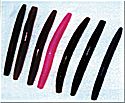
Their plain design can easily identify this variety of soft plastic baits. These lures often look like plastic French fries or cigar-shaped lures. These baits look like a joke to some anglers since there is no way they could attract fish. Not true. Even though many American anglers overlook these two bait types in favor of the "cooler looking" plastics, these baits are very popular in Japan. In fact, up until just recently, the Japanese record bass was taken on a Bass Foods brand French Fry style worm.
French fry baits are manufactured in lengths from 2 to 6 inches, with 4 inches being the most popular size. French fry baits can be fished in the previous five manners mentioned. They can also be fished "wacky worm" style, which involves rigging the bait with the hook running directly through the middle of the worm.
Senko Plastics, produced by Gary Yamamoto, are slightly different. These narrow tapered lures look like elongated cigars. Senkos can be fished as Texas- or Carolina-rigged worms but are most often fished fluke style.
This method of presentation involves Texas-rigging the lure with just a hook and no weight. The bait is fished just as you would a fluke - retrieved with short jerks and pauses to make the bait dart through the water like a minnow chasing food.
Grubs
Grubs have long been a standby favorite among anglers. These lures can have a straight tail, split tail, beaver tail, single curly tail, or double curly tail and come in various lengths. These lures are often fished using a Carolina or split shot rig and are effective when the fish seem to be a little on the picky side. Some people occasionally use a curly tail grub as a trailer on a spinnerbait or jig. Grubs are also popular to fish as a dropshot bait - more on that later.
The ranking king of grubs is Gary Yamamoto Custom Baits. GYCB offers well over a dozen different sizes and styles of grubs in 100 colors! If you need help finding the bait you need here, odds are you're out of luck, to begin with.
Since grubs are a relatively standard bait, there has been little design variation in recent years. The most significant things to happen to grubs have been the inclusion of zipper baits and baits with realistic-looking eyes. Some of the nicer grubs on the market are the Zipper Grub, Cabela's livin' eye series grubs, and Assalt's new series of highly salt-impregnated grubs.
Reapers
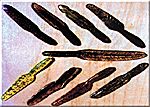
Reapers are a basic variation of the grub. A reaper resembles a small leach rather than a standard grub. Imagine a worm with an upper body like Olive Oil and a lower body like Rosie O'Donnell - this is a Reaper. Reapers are usually smaller than 4 inches and are typically fished on light lines during tough bites.
Reaper fishing got its roots in the deep and clear California reservoirs. Most anglers use a split shot rig for fishing these baits on 6- to 8-pound test. However, the light weight of the entire outfit forced most anglers to fish this bait on spinning gear. Shad, black, and crawdad patterns usually are the most effective reaper colors, although chartreuse/ black fleck has been a solid producer for me lately.
Reapers are good baits to throw on lakes with much angling pressure, such as the San Diego lakes in Southern California.
Tube Baits

When it comes to tube baits, Bobby Garland is the man. He successfully used his Gitzit series of tube baits to win many a west coast tournament in the late 70s. His company has also spawned a variety of imitations.
Today, tube baits are offered in several sizes, with or without eyes. Companies like Zoom, Big Bite Baits, Gambler Worms, Berkley, and Strike King lures produce and sell tube baits. Tube baits can be fished with a jig head, with a splitshot rig, or without a weight. The tube bait is primarily a baitfish imitation that is effective throughout the year. Tube baits are often used as a follow-up bait by anglers who miss bass hitting their surface plugs but not taking the bait. The lightweight body of the tube lure allows the bait to fall very slowly - the lure is so light that most anglers have to use spinning gear with light line to cast it when rigged without a weight.
The hollow body of the tube bait is also ideal for holding after-market spray scents. I usually use one of these spray scents to lubricate the plastic before slipping in a jig head.
You can fish the tube bait like any other swimming-type jig when rigged with a jig head. However, the tube jigs fall in a spiral motion, and most of your strikes will happen when the bait falls, so be aware of this.
Crawdads / Craw Worms
I tend to bunch plastic crawdad lures into two groups - realistic crawdads and worm-type crawdads. As the name implies, realistic crawdads are baits that took like real crawdads. The Savage Gear 4D Craw and the Huddleston Huddle Bug are perfect examples of these. These baits typically involve the use of a jig head and, as such, are primarily limited to jig-like presentations.
The second category is the worm-type crawdads or "Craw Worms." This group has a more significant number of baits that fall under its auspices. These baits include NetBait’s Paca Craw, Strike King Rage Craw, Berkley's Powerbait Maxscent Lil Super Trooper Craw, Zoom's Critter Craw, and the Yum Christie Craw, among others. The Craw worm has the advantage of being fished in almost every way imaginable. From use as a jig trailer to duty as a flipping or pitching bait to being fished like a Texas rigged worm, the craw worm offers the angler much more versatility than most realistic crawdad imitations.
Lizards
Lizards are baits most effective during certain times of the year and on specific bodies of water. For example, salamanders are major predators during the spawn, and this can be one of the most effective times of year to fish a lizard. Lakes with a good natural population of salamanders can also be good bets for lizard baits.
Lizards are often flipped or pitched but can also be fished effectively on a Texas rig, just like a regular worm. The lizard is primarily a reaction bait, reflected in the bright contrasting colors like black/chartreuse and black/orange that the manufacturers produce. Almost every factory builds a lizard-style bait, including RageTail, Berkley, Zoom, Gene Larew, Mister Twister, and Creme.
Spider Jigs
Spider Jigs are a soft plastic variation of the original bucktail jig. What makes the spider jig so much different, though, is the availability of multiple colors and actions that can be imparted into the bait through the lure manufacturing process. Some of the first spider jigs were produced by Bobby Garland. Today, factories, including Gary Yamamoto, Assault, Gene Larew, Chompers, Zipperworm, and Berkley, are all making a spider-style jig.
As the name implies, spider jigs are often fished as just that - jigs. A lead head jig is inserted through the front of the bait and is crawled along the bottom as a crawfish imitation. Some anglers will fish spider jigs in open water for suspended schooling fish, while others may occasionally use them for flippin' or pitchin'.
With the recent introduction to downshotting, some more astute anglers are starting to use smaller spider jigs as a part of their downshotting setup.
Fluke Baits
Flukes, or soft jerkbaits, as they have become known, have gained tremendous popularity in recent years. This is partly because they are a fun lure to fish and partly because they catch fish! Bass Assassin, Big Bite Baits, and Zoom are some of the better-known fluke manufacturers. Flukes are fished with a larger-than-normal worm hook due to the rigging requirements of the lure. Not only is the larger, wide-gap hook necessary to pull through all the plastic, but the weight of the hook also acts as a keel to keep the bait upright in the water. Some anglers who need to add casting distance or depth to the lure will use insert weights in the nose or body of the bait.
Whew! There are a lot of soft plastic baits on the market, and I've missed a few, I'm sure. But first, each angler must decide which exciting products to put in his tacklebox. And even then, as soon as you learn to fish one bait, another will be out to take its place. It might have all started with an inner tube, but I can guarantee it won't stop with what's on the market today. Somebody will continue to build a better mousetrap.
Reprinted with permission from Bass West Magazine
BassResource may receive a portion of revenues if you make a purchase using a link above.


